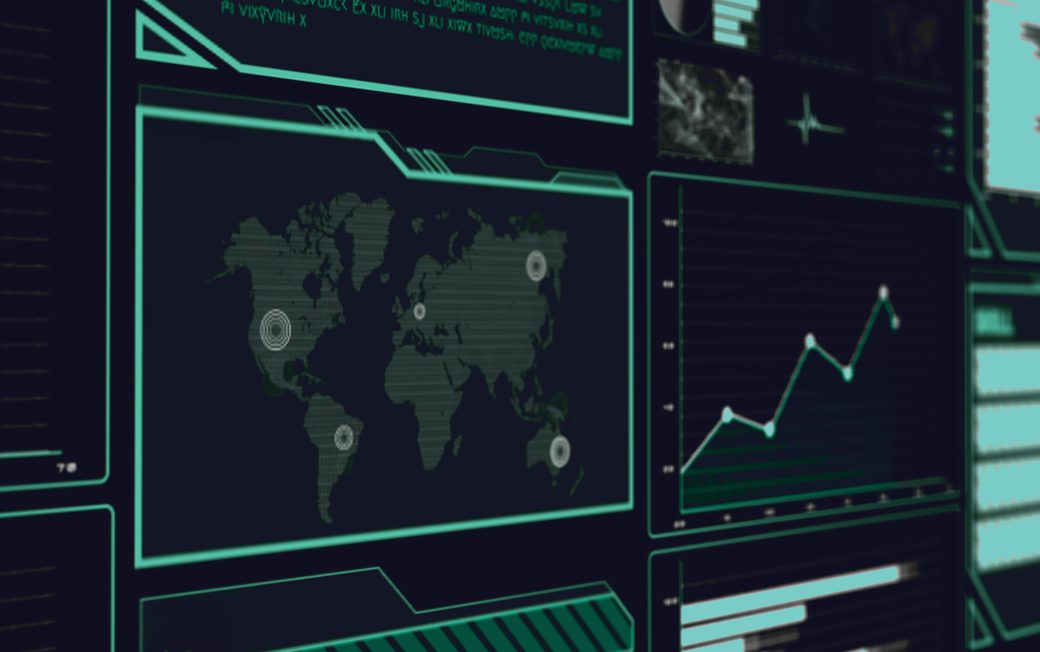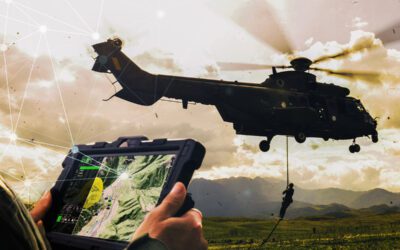The defence sector is constantly evolving, driven by technological advancements and the need to adapt to emerging threats. In recent years, with the emergence of several influential technologies, the pace of innovation has increased dramatically. Many experts argue that the defence sector is on the brink of significant evolution and that these technologies will revolutionise how we fight conflicts over the next few decades.
This guide provides an overview of some of the most prominent emerging disruptive technologies in the defence sector, highlighting their potential impact and applications. But before we begin, let’s look at how disruptive technology is defined and the context in which the term is applied.
Defining emerging disruptive technologies in defence
The European Defence Fund (EFD) defines disruptive defence technology as ‘enhanced or completely new technology that brings about a radical change, including a paradigm shift in the concept and conduct of defence affairs such as by replacing existing defence technologies or rendering them obsolete’ (European Parliament).
NATO places itself at the centre of its thinking by defining the term as ‘technologies or scientific discoveries that are expected to have a major, or perhaps revolutionary, effect on NATO defence, security or enterprise functions’ (European Parliament). EDT’s aid in preparing Alliance forces and improves NATO’s ability to operate in the future security environment.
But what constitutes a disruptive technology? At one point in time, the longbow, tank and satellite systems were all disruptive technologies. What are today’s disruptive defence technologies? And how do we expect them to change the world?
Over the next 20 years, NATO expects four core characteristics to define many key advanced military technologies:
- Intelligent – Solutions will exploit integrated AI, knowledge-focused analytic capabilities and symbiotic AI-human intelligence, resulting in the spread of disruptive applications across the technological spectrum.
- Interconnected – Solutions will take advantage of the growing network of virtual and physical domains. This will include networks of sensors, organisations, individuals and autonomous agents, linked via new encryption methods and distributed ledger technologies.
- Distributed: Solutions will employ decentralised and ubiquitous large-scale sensing, storage and computation to achieve new disruptive military effects.
- Digital: Solutions will blend human, physical and information domains to support novel disruptive effects.
NATO also details nine areas of innovation it believes will prove particularly disruptive to the global defence sector over the coming years. They are:
- Artificial Intelligence (AI)
- Autonomy
- Quantum
- Biotechnologies and human enhancement
- Hypersonic systems
- Space
- Novel materials and manufacturing
- Energy and propulsion
- Next-generation communications networks
This means the following technologies are likely to play a key role in EDT development.
Artificial Intelligence (AI)
AI is rapidly transforming the defence sector, offering enhanced capabilities when it comes to autonomous systems, data analysis and decision-making. As the amount of data militaries have access to increases, so does their ability to develop powerful AI systems that can identify threats and targets, mitigate risk and improve decision-making. In some contexts, militaries will use AI to reduce the scope for human error in military exercises by automating processes. However, militaries will also use it to augment human capabilities and provide participants with more information to base their decisions on.
At the same time, AI will play a key role in defence sector infrastructure. It will leverage predictive capabilities to manage maintenance for military assets, direct technology development and assist with product testing.
Internet of Things (IoT)
The emergence of the IoT as a network of interconnected devices that can exchange data and perform tasks without human intervention will generate vast amounts of valuable data. This will provide militaries with greater insight into operational environments, capabilities and performance. Technologies like wearable devices, sensors, and drones can all feed back insights, resulting in a more complex and comprehensive account of what is happening on the ground in any given location.
These interconnected systems enhance situational awareness, enable real-time monitoring of assets and optimise logistics and supply chain management. By facilitating data sharing and some degree of automation, they can also streamline decision-making and reduce response time.
Quantum computing
Historically, quantum computing is arguably the technology that has had the least impact on the defence sector. But that will soon change. It has the potential to revolutionise cryptography and computational power, with applications in areas like secure communication, code-breaking, and complex simulations.
Quantum computers can solve complex problems exponentially faster than traditional computers and are extremely sensitive to environmental changes, ensuring they offer a significant advantage in target identification, weather forecasting and data analysis. Additionally, quantum sensors offer improved detection capabilities, enhancing early warning systems and threat identification
Hypersonic technology
Hypersonic technology refers to combat equipment that travels at speeds exceeding Mach 5. And it represents a game-changing capability in the defence sector. That said, it is not their speed that makes them valuable. Instead, it is their manoeuvrability.
Hypersonic missiles can evade traditional defence systems, enabling rapid strike capabilities and enhanced deterrence. They typically come in two forms, Hypersonic Cruise Missiles (HCM) and Hypersonic Glide Missiles (HGM). Both are difficult to detect and effective countermeasures are not yet widely available. The US has shown particular interest in hypersonic technology and recently increased research funding to $4.7 billion from $3.8 billion in 2022 (USNI).
Cybersecurity
As digital connectivity increases, the defence sector faces an ever-growing threat from cyberattacks. Disruptive technologies in cybersecurity include advanced encryption methods, blockchain technology for secure data sharing and artificial intelligence-based threat detection systems. Cybersecurity measures are essential for protecting critical infrastructure, ensuring the integrity of military systems, and safeguarding sensitive information.
Additive manufacturing (3D printing)
Additive manufacturing, commonly known as 3D printing, could transform the way we think about defence-sector supply chains and logistics. It allows for rapid prototyping, on-demand production of spare parts and equipment customisation. The technology reduces the time and cost required for manufacturing, increases flexibility and enables the production of complex geometries that are difficult to achieve through traditional manufacturing processes.
At the same time, it could make equipment lighter, stronger and easier to carry, radically altering performance capabilities in the field and improving mobility. It can be deployed in the field, allowing for quick solutions to supply chain issues and potentially facilitating the decentralisation of logistical decision-making.
Robotics and autonomous weapons systems
Autonomous weapons systems are possibly the most controversial technological defence sector development for quite some time. They allow for the removal of human agency from decision-making processes and conflict oversight, improving performance outcomes but also possibly opening the door to a new, less transparent and less accountable form of warfare.
The debate over autonomous weapons systems and the extent to which they should be independent of human intervention is still a major sticking point. The lack of clarity and scope for confusing grey areas is apparent in the language coalescing around this developing technology. Experts talk of ‘human out of the loop’ and ‘human in the loop’ systems, as well as ‘fully autonomous’ designs. While there are questions as to how robotics and autonomous weapons fit into the current legal framework for conflicts, that has not stopped countries from investing considerable amounts in developing their autonomous capabilities.
Emerging military technology and a rapidly changing defence sector
The defence sector is at the forefront of technological innovation, driven by the need to maintain military superiority, address emerging threats and safeguard national security. In this article, we analysed some of the critical disruptive technologies influencing current defence sector decision-making.
The disruptive technologies mentioned in this guide have the potential to reshape the defence landscape and governments will need to stay abreast of the local developments if they are to maintain a strategic and operational advantage. EU-wide cooperation is crucial to the development of effective EDTs and developing a shared vision via conferences and industry events is key.
FlySight designs and develops geospatial software solutions for mission-critical scenarios. Our multi-platform Processing, Exploitation and Dissemination (PED) system, OPENSIGHT, provides real-time support to decision-makers by providing them with AI-driven insights and advanced capabilities. From AR overlays to automatic target recognition functionality, OPENSIGHT provides users with a diverse range of capabilities that enhance operational and strategic decision-making.
To learn more about FlySight defence sector technologies, head to the OPENSIGHT product page or get in touch with our expert team via marketing@flysight.it or our online contact form.
Below, you’ll find further insights and news about FlySight involvement and networking efforts for Emerging Disruptive Technologies (EDT):
–> Emerging & Disruptive Technologies: Networking in a common vision (flysight.it)
–> DEFENCE INNOVATION CONFERENCE IN PRAGUE – The EU Conference (flysight.it)




